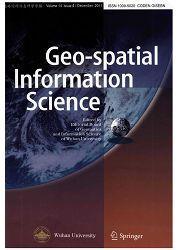结合植被物候特征和极化特征的面向对象草地类型识别技术
IF 4.4
1区 地球科学
Q1 REMOTE SENSING
引用次数: 0
摘要
由于草本植被面积小、种类多、混合程度高,基于遥感的草地类型识别主要集中在提取主要草地类别上,缺乏详细的描述。这一局限性极大地阻碍了对草原资源合理利用进行有效评价和精细监管的发展。为解决这一问题,本研究以内蒙古正兰旗代表性草原为研究区域。结合Sentinel-1和Sentinel-2主被动协同观测的优势,创新引入面向对象的草地类型分类技术,提高了草地分类的精度和精细化程度。结果表明:(1)为满足草地资源监管要求,提出了一种基于遥感的草地类型分类体系和植被-生境分类方法,该方法特别适用于中国北方天然草地。(2)利用基于时空非局部滤波融合模型(STNLFFM)合成的高空间分辨率归一化植被指数(NDVI),能够捕获草地类型的NDVI时间特征,准确提取年内植被物候信息,进一步提高时间分辨率。(3)多季节光谱、极化和物候特征的整合显著提高了草地类型的分类精度。总体准确率达到82.61%,kappa系数为0.79。与仅使用多季节光谱特征相比,精度和kappa系数分别提高了15.94%和0.19%。缓坡草原的精度提高幅度最大,达到38%以上。(4)研究区沙质草地分布最广,草地植被生长季节主要发生在5 ~ 9月。与典型草地和草甸相比,沙质草甸的生长季节更长,物候特征的显著差异有助于准确识别各种草地类型。本文章由计算机程序翻译,如有差异,请以英文原文为准。
Integrating vegetation phenological characteristics and polarization features with object-oriented techniques for grassland type identification
Due to the small size, variety, and high degree of mixing of herbaceous vegetation, remote sensing-based identification of grassland types primarily focuses on extracting major grassland categories, lacking detailed depiction. This limitation significantly hampers the development of effective evaluation and fine supervision for the rational utilization of grassland resources. To address this issue, this study concentrates on the representative grassland of Zhenglan Banner in Inner Mongolia as the study area. It integrates the strengths of Sentinel-1 and Sentinel-2 active-passive synergistic observations and introduces innovative object-oriented techniques for grassland type classification, thereby enhancing the accuracy and refinement of grassland classification. The results demonstrate the following: (1) To meet the supervision requirements of grassland resources, we propose a grassland type classification system based on remote sensing and the vegetation-habitat classification method, specifically applicable to natural grasslands in northern China. (2) By utilizing the high-spatial-resolution Normalized Difference Vegetation Index (NDVI) synthesized through the Spatial and Temporal Non-Local Filter-based Fusion Model (STNLFFM), we are able to capture the NDVI time profiles of grassland types, accurately extract vegetation phenological information within the year, and further enhance the temporal resolution. (3) The integration of multi-seasonal spectral, polarization, and phenological characteristics significantly improves the classification accuracy of grassland types. The overall accuracy reaches 82.61%, with a kappa coefficient of 0.79. Compared to using only multi-seasonal spectral features, the accuracy and kappa coefficient have improved by 15.94% and 0.19, respectively. Notably, the accuracy improvement of the gently sloping steppe is the highest, exceeding 38%. (4) Sandy grassland is the most widespread in the study area, and the growth season of grassland vegetation mainly occurs from May to September. The sandy meadow exhibits a longer growing season compared with typical grassland and meadow, and the distinct differences in phenological characteristics contribute to the accurate identification of various grassland types.
求助全文
通过发布文献求助,成功后即可免费获取论文全文。
去求助
来源期刊

Geo-spatial Information Science
REMOTE SENSING-
CiteScore
10.10
自引率
28.30%
发文量
710
审稿时长
31 weeks
期刊介绍:
Geo-spatial Information Science was founded in 1998 by Wuhan University, and is now published in partnership with Taylor & Francis. The journal publishes high quality research on the application and development of surveying and mapping technology, including photogrammetry, remote sensing, geographical information systems, cartography, engineering surveying, GPS, geodesy, geomatics, geophysics, and other related fields. The journal particularly encourages papers on innovative applications and theories in the fields above, or of an interdisciplinary nature. In addition to serving as a source reference and archive of advancements in these disciplines, Geo-spatial Information Science aims to provide a platform for communication between researchers and professionals concerned with the topics above. The editorial committee of the journal consists of 21 professors and research scientists from different regions and countries, such as America, Germany, Switzerland, Austria, Hong Kong and China.
 求助内容:
求助内容: 应助结果提醒方式:
应助结果提醒方式:


